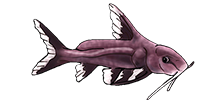https://onlinelibrary.wiley.com/doi/ful ... /jfb.70001
VIDEO of live fish: Video S1. Dorsal view of Lophiosilurus alexandri in a glass tank to observe the movement of the pectoral fins.
Abstract
Pseudopimelodidae comprises 49 species of freshwater catfish endemic to South America, with limited research on their acoustic behaviour. This study focuses on the pacamã Steindachner, 1876, a vulnerable catfish species endemic to the São Francisco River basin, known for its ecological and economic importance. Sound production by this species was analysed for the first time. Three individuals were recorded while being held underwater revealing the production of two distinct sound types (type I and type II) associated with pectoral fin movements (abduction and adduction). Sounds were 85–135 ms long with a variable number of pulses or peaks. Type II sounds were longer and louder than type I sounds, with both types showing a similar peak frequency ranging between 200 and 500 Hz. The sounds were produced alternately by the pectoral fins, with occasional lateralization. More research is needed to determine whether these sounds can be used for monitoring or if they lack sufficient species-specific characteristics.





